


Navigating the regulatory landscape of the medical technology sector presents a significant challenge for innovators, especially given the FDA's stringent guidelines in the UK. Medtech companies have a unique opportunity to streamline their compliance processes, which can enhance their chances of successful product launches and market entry. However, with evolving regulations and increasing enforcement scrutiny, how can these innovators effectively manage the complexities of FDA compliance while ensuring patient safety and product efficacy? This article explores the ten key FDA regulations that every Medtech innovator must grasp to thrive in this dynamic environment.
bioaccess® excels in guiding Medtech innovators through the complex landscape of regulations from the FDA in the UK, leveraging over 15 years of experience to streamline compliance processes. By employing tailored strategies that align with the FDA in UK expectations, bioaccess® significantly reduces time to market, enhancing the chances of successful product launches. For instance, products that engage in pre-submission meetings with the FDA enjoy a 52% approval rate, compared to just 29% for those that do not.
Additionally, approximately 85% of 510(k) applications receive a Substantially Equivalent decision, underscoring the importance of understanding the submission process for compliance and smooth review. Regulatory specialists highlight that thorough preparation and clear communication with the FDA in the UK are crucial for avoiding common pitfalls, which ensures that submissions are complete and accurately identify predicate products. As Leslie Williams notes, "Meticulous preparation is essential to avoid common pitfalls that can delay market entry."
By integrating these insights into their services, bioaccess® empowers Medtech companies to achieve compliance swiftly and efficiently, ultimately driving innovation and improving patient outcomes. Moreover, with expected staff cuts at the FDA, the necessity for knowledge in managing these compliance challenges has never been more essential.
Significantly, bioaccess® has effectively partnered with Welwaze Medical Inc. to support the introduction of the Celbrea® medical instrument in Colombia, demonstrating its dedication to speeding up clinical trials and access to regulations in Latin America. This partnership exemplifies bioaccess®'s role in enhancing market entry strategies for Medtech innovators, ensuring they are well-positioned to meet both local and international regulatory standards.

The premarket approval (PMA) process by the FDA in the UK is essential for Medtech innovators, comprising several critical steps.
Understanding these steps is crucial for Medtech companies to navigate the regulatory landscape, particularly the FDA in the UK, effectively and achieve timely market entry.
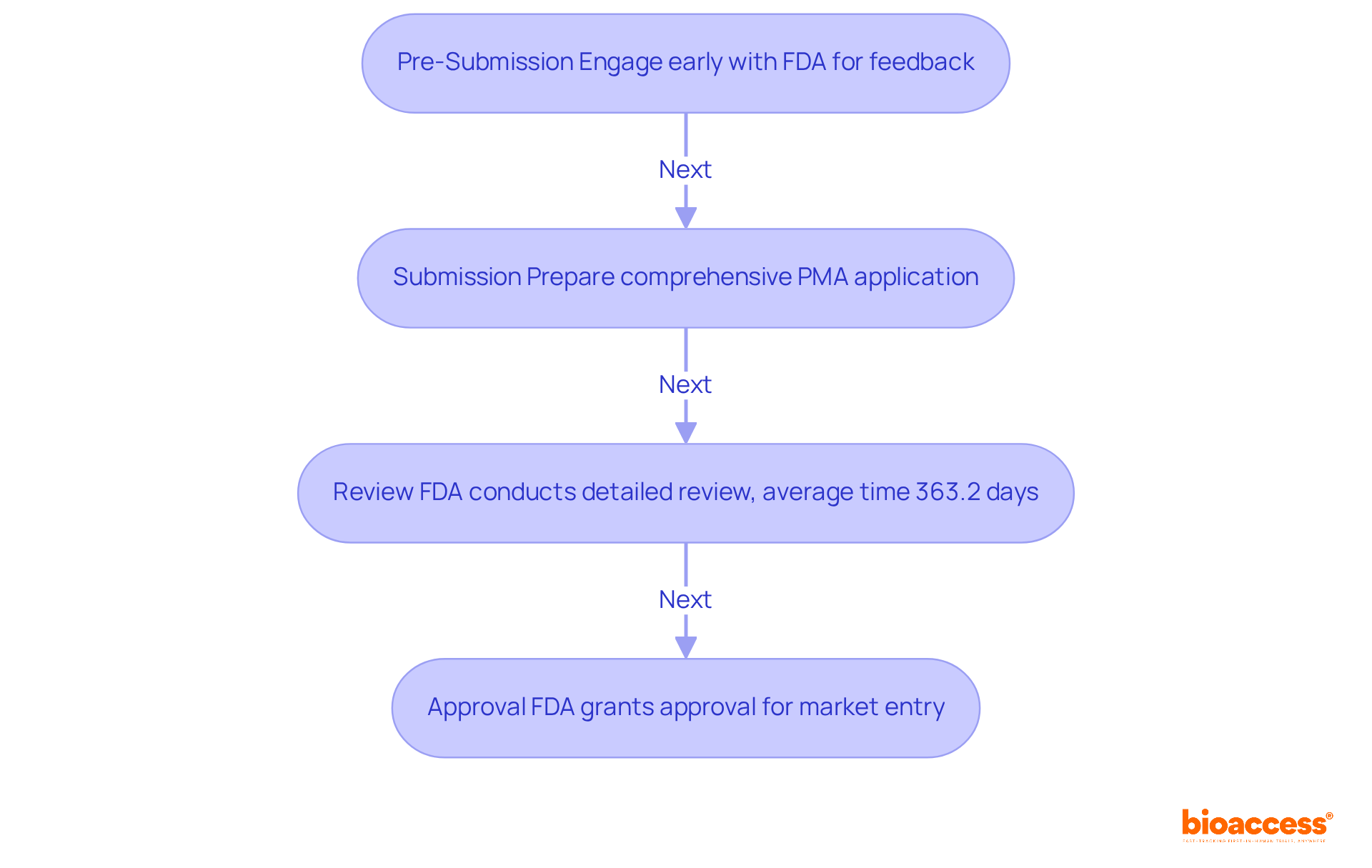
The FDA's clinical trial guidelines underscore the critical need for rigorous study design and ethical considerations, ensuring participant well-being and data integrity. These guidelines are not just recommendations; they are essential for maintaining the credibility of clinical research.
Informed Consent is a cornerstone of these guidelines. Participants must receive comprehensive information about the trial's purpose, potential risks, and expected benefits. This transparency is vital, as many patients may not fully understand terms like 'Breakthrough' designation, which can mislead them regarding a drug's effectiveness. By ensuring informed consent, researchers empower participants to make educated decisions about their involvement.
Study Design is another key component. Trials must be meticulously structured to minimize bias and enhance data reliability. Successful clinical trial designs in Medtech often incorporate adaptive methodologies, allowing for modifications based on interim results. This flexibility increases the likelihood of achieving meaningful outcomes. At bioaccess®, we leverage over 20 years of experience to manage Early-Feasibility Studies (EFS), First-In-Human Studies (FIH), and other pivotal studies, ensuring our clients benefit from strategic design choices that enhance trial success.
Data Monitoring is mandated throughout the trial, requiring continuous oversight of participant well-being and data quality. Data Monitoring Committees (DMCs) play a crucial role in assessing data related to risks and advising on the continuation or alteration of the trial. Bioaccess® implements robust data monitoring protocols to uphold participant safety, drawing on our extensive expertise in clinical research.
Reporting is equally important. All adverse events must be reported to the FDA in the UK promptly, facilitating swift action to protect participants and maintain the integrity of the trial. The commitment of the FDA in the UK to transparency is evident in its encouragement of voluntary compliance with reporting requirements. At bioaccess®, we equip our clients with the necessary tools and support to meet these obligations efficiently.
Conducting clinical trials in Latin America offers distinct advantages, such as access to diverse patient groups and streamlined compliance procedures, which can accelerate study timelines. Adhering to these guidelines is vital for ensuring the credibility of trial results and safeguarding participant welfare. Experts emphasize the ethical obligations of researchers to uphold these standards, reinforcing the importance of rigorous oversight in clinical research. With bioaccess®'s expertise in accelerated clinical study services, we are dedicated to helping Medtech innovators navigate the compliance landscape effectively.
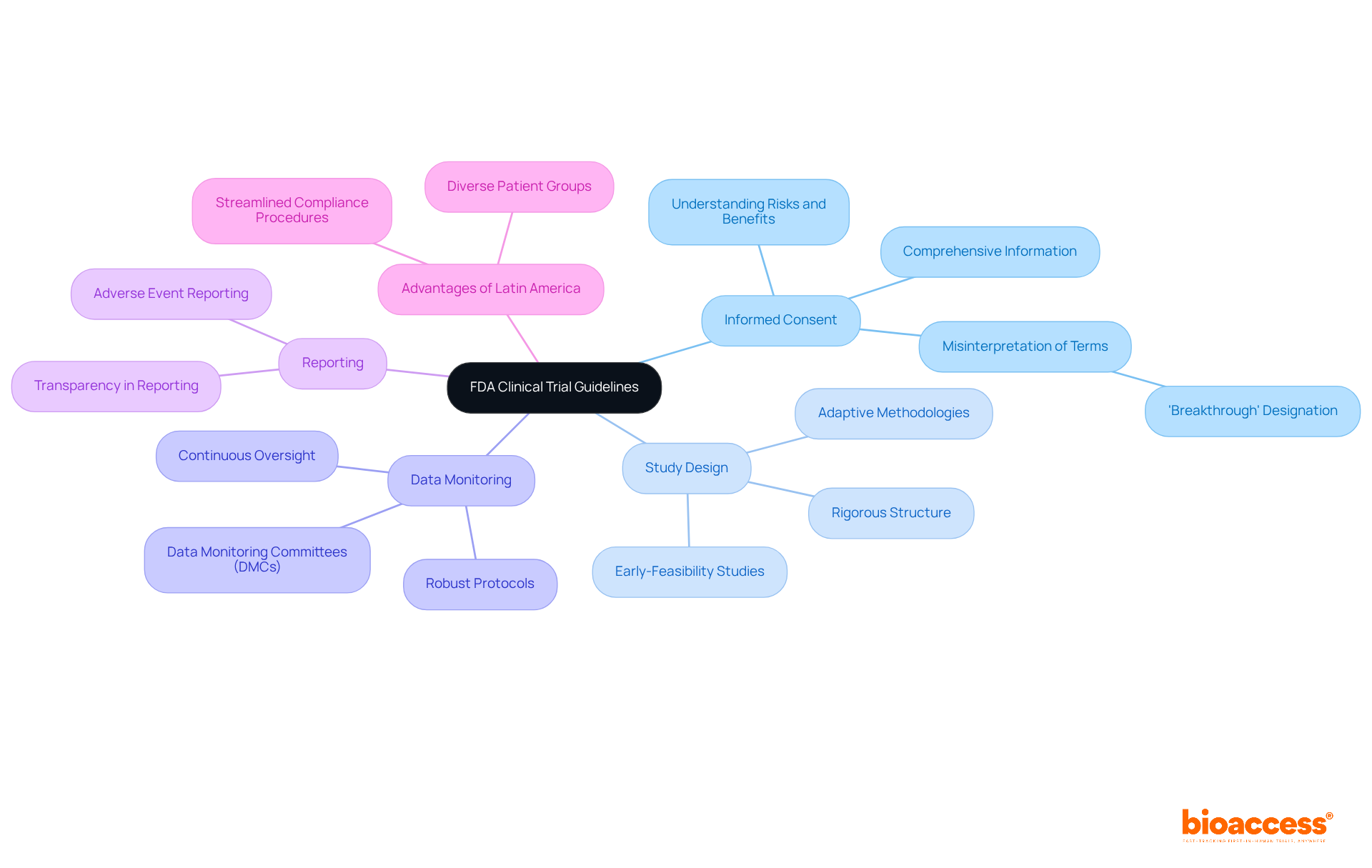
Post-market surveillance plays a crucial role in the FDA's oversight system, compelling manufacturers to monitor the performance and effectiveness of their products once they hit the market. This process is not just a regulatory formality; it’s essential for ensuring patient safety and product reliability.
Adverse Event Reporting is a key requirement, mandating that manufacturers report any adverse events linked to their devices within thirty days of awareness. This timely reporting is vital for identifying potential risks early, ensuring ongoing compliance with regulatory standards.
In addition, the FDA may require Post-Market Research to gather further information on long-term safety and effectiveness, particularly for higher-risk products. Such studies are indispensable for demonstrating a device's reliability and effectiveness in real-world settings.
Moreover, Tracking Technology is necessary for specific equipment, ensuring accountability and facilitating recalls when necessary. This requirement significantly enhances patient safety by enabling manufacturers to quickly identify and address issues related to particular devices.
Furthermore, companies must adopt comprehensive Risk Management strategies to proactively tackle potential safety concerns. This includes establishing corrective and preventive action (CAPA) processes to evaluate and mitigate risks associated with device performance.
Experts emphasize that effective post-market monitoring not only fulfills compliance obligations but also fosters innovation and enhances patient safety. As industry leaders point out, the data collected from post-market studies can reveal areas for improvement, ultimately leading to safer and more effective medical products. Recent trends show that manufacturers prioritizing these activities are better equipped to navigate the evolving regulatory landscape and sustain market authorization.
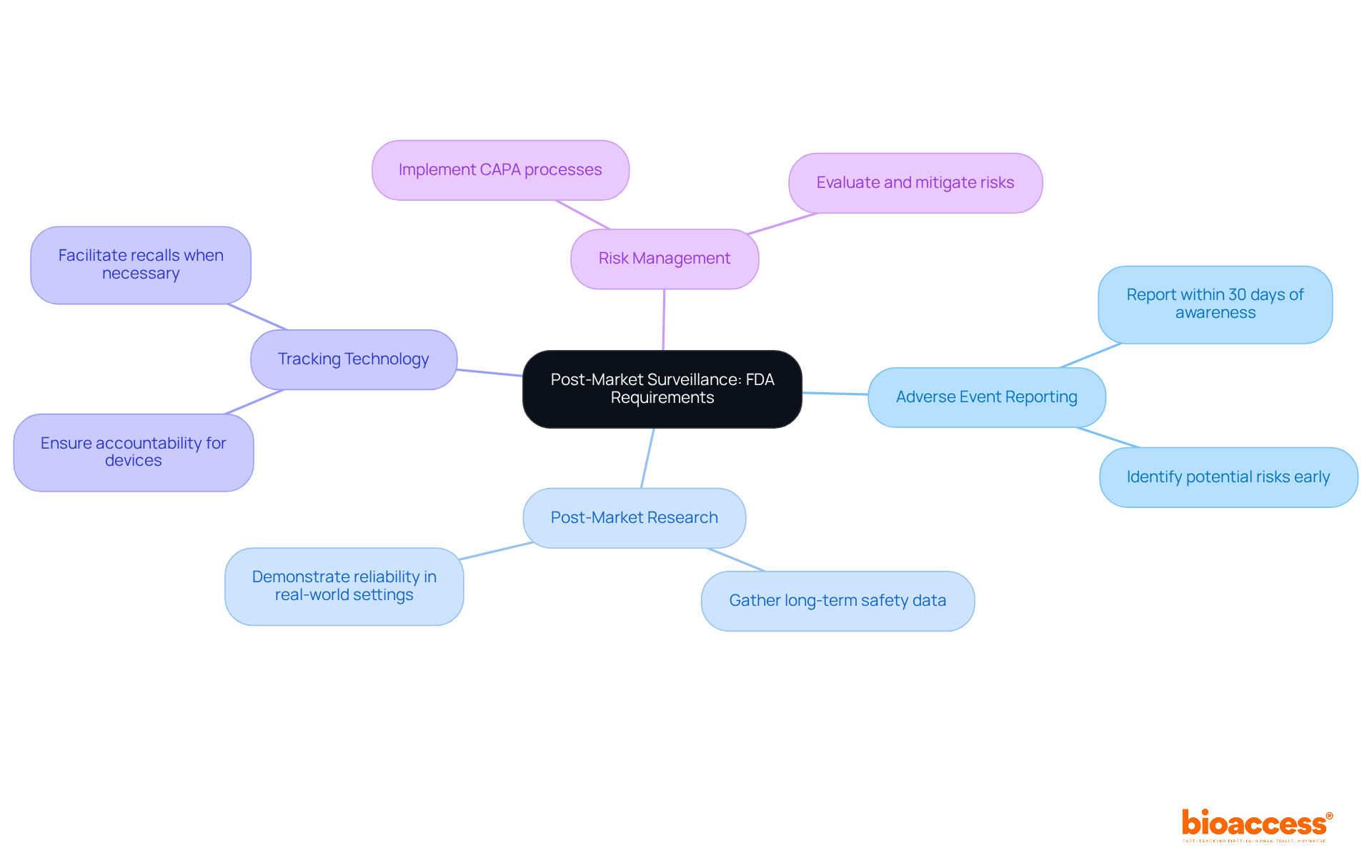
FDA medical equipment labeling regulations are designed to ensure that labels convey clear and precise information to users, which is vital for both safety and compliance. Key requirements include:
Adhering to these labeling guidelines is essential not only for gaining approval but also for enhancing user protection. As industry experts emphasize, effective labeling practices can significantly reduce the risk of noncompliance, which often leads to enforcement actions and delayed market access. Moreover, the FDA in the UK emphasizes that clear, precise, and thorough labeling is crucial for the safety and efficacy of medical equipment, as detailed in 21 CFR Part 801.
With the worldwide medical equipment labeling market expected to expand at a CAGR of 5.3% from 2023 to 2031, effective labeling strategies will be crucial for Medtech innovators. They must navigate the complexities of compliance with regulations and market access, ensuring that their products meet the highest standards of safety and effectiveness.
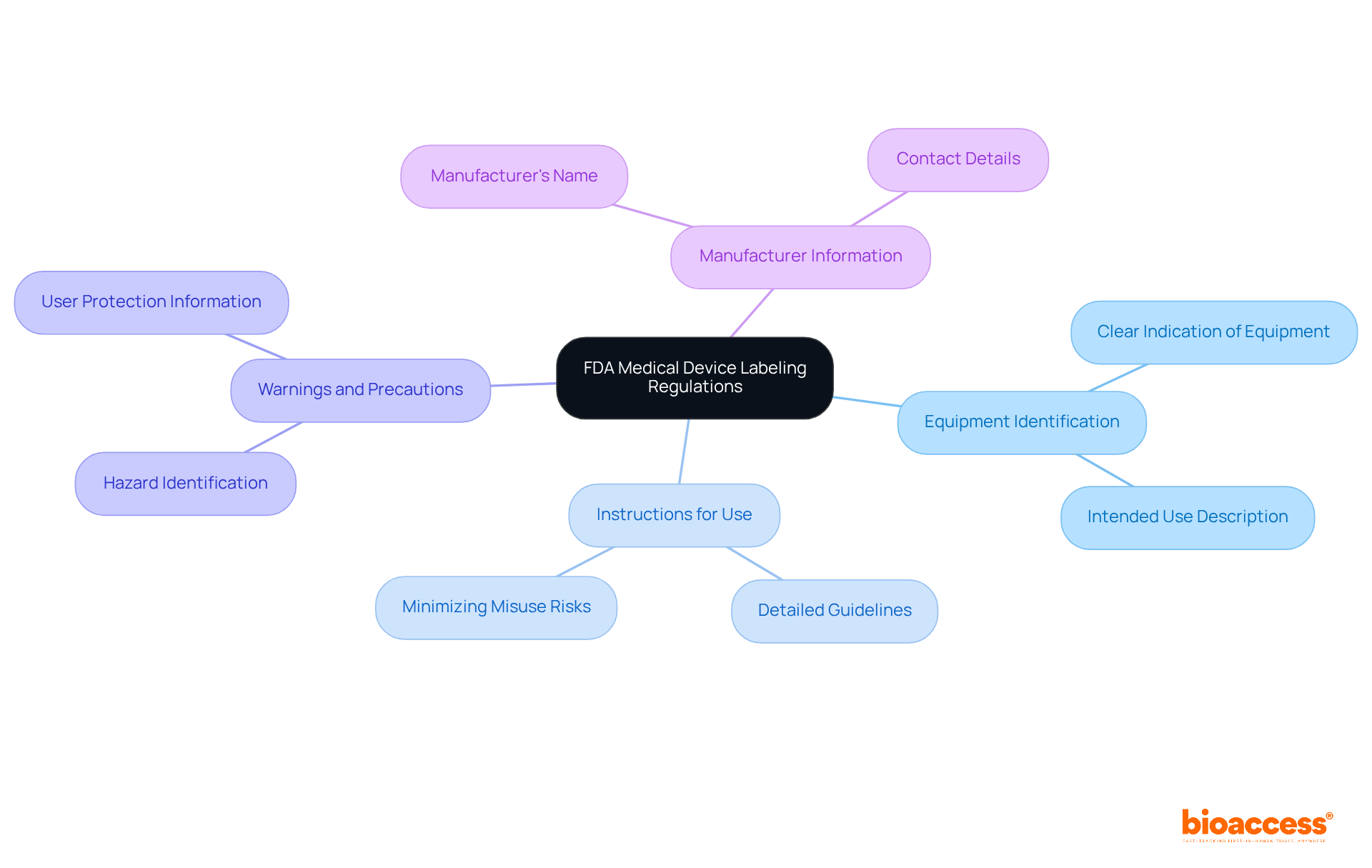
The regulations established by the FDA in the UK for digital health technologies, including software as a medical device (SaMD), carry significant implications for innovators in the Medtech space. Understanding these regulations is crucial for navigating the complexities of the industry.
Regulatory Classification is a primary consideration. Digital health products must be categorized based on their intended use and associated risk levels, ensuring that appropriate oversight pathways are followed. This classification is essential for compliance and market entry.
Another critical aspect is Clinical Evidence. Developers are required to provide robust clinical evidence demonstrating the safety and effectiveness of their products. This step is vital for gaining regulatory approval and instilling confidence in users and stakeholders alike.
Cybersecurity Requirements cannot be overlooked. Manufacturers must proactively address cybersecurity risks linked to their products. This includes implementing comprehensive risk management processes to identify and mitigate potential vulnerabilities throughout the product lifecycle. The FDA's guidelines emphasize that interconnected medical equipment must maintain data integrity and security, reflecting the evolving threat landscape.
Additionally, Post-Market Monitoring is mandated. Continuous monitoring of digital health products ensures ongoing compliance and safety. This involves regular assessments of cybersecurity measures and timely updates to address any identified vulnerabilities, reinforcing the commitment to patient safety.
Successful examples of compliance with these regulations can be observed in various digital health products that have effectively navigated the FDA in UK requirements. These cases highlight the importance of integrating cybersecurity into the development process. As the landscape of digital health technologies continues to evolve, adherence to these regulations will be crucial for innovators aiming to bring safe and effective solutions to market.
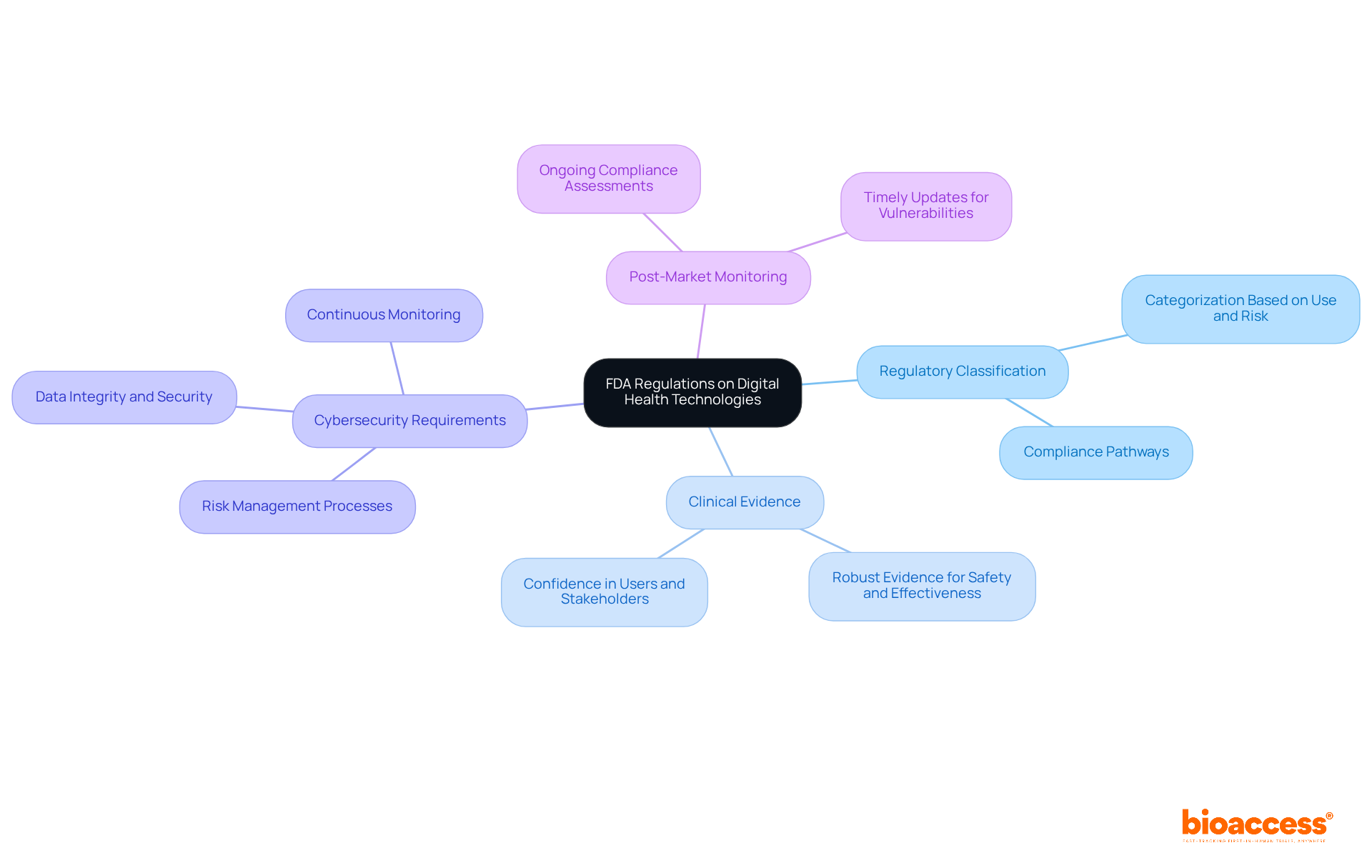
Combination products, which integrate a drug with a device or a biologic, are governed by specific regulations from the FDA in UK that Medtech innovators must navigate with precision. Understanding the regulatory landscape is crucial for success in clinical research.
In the realm of clinical trials, bioaccess® offers a suite of comprehensive services, including feasibility studies, site selection, compliance reviews, trial setup, import permits, project management, and reporting. Their expertise in managing early-feasibility studies, first-in-human studies, pilot studies, pivotal studies, and post-market clinical follow-up studies positions them as a valuable partner in navigating the complexities of clinical trials in Latin America. Recent updates in 2025 underscore the commitment of the FDA in the UK to refining regulations for combination products, introducing new guidelines that emphasize user-related risk analyses and their integration into human factor studies. Furthermore, the FDA in the UK Breakthrough Device Program aims to accelerate the development of groundbreaking medical devices, providing additional context for approval routes. Understanding these requirements is vital for successfully navigating the compliance environment in the Medtech sector.

FDA enforcement actions, particularly the FDA in UK, present significant risks for Medtech companies, especially in 2025, as the agency has ramped up its scrutiny. Key risks include:
Warning Letters: These letters are issued for violations of FDA regulations and can lead to increased scrutiny and operational challenges. In 2025, the FDA in the UK issued 19 warning letters for violations of the Quality System Regulation (QSR), which surpassed the total for the same period in 2024. This uptick reflects a more enforcement-minded agency, emphasizing the critical need for compliance.
Product Recalls: Non-compliance can trigger mandatory recalls, disrupting operations and tarnishing a company's reputation. For instance, two deaths linked to safety issues with Baxter pumps highlight the serious repercussions of oversight failures.
Fines and Penalties: The FDA has the authority to impose substantial fines for compliance violations, which can strain financial resources and impact long-term viability.
Increased Inspections: Companies with a history of violations may face more frequent inspections, leading to heightened operational burdens. Recent inspections by the FDA in the UK revealed non-conformities with good manufacturing practices, underscoring the importance of maintaining rigorous quality controls.
Industry leaders stress that the implications of FDA warning letters extend beyond immediate compliance issues. Matthew G. Hillebrenner from the FDA noted serious problems in manufacturing and quality management systems at companies like Philips, which faced multiple warning letters in 2025. This situation demonstrates the essential requirement for Medtech innovators to adopt robust compliance strategies to mitigate risks and ensure sustainable growth in a demanding oversight environment.
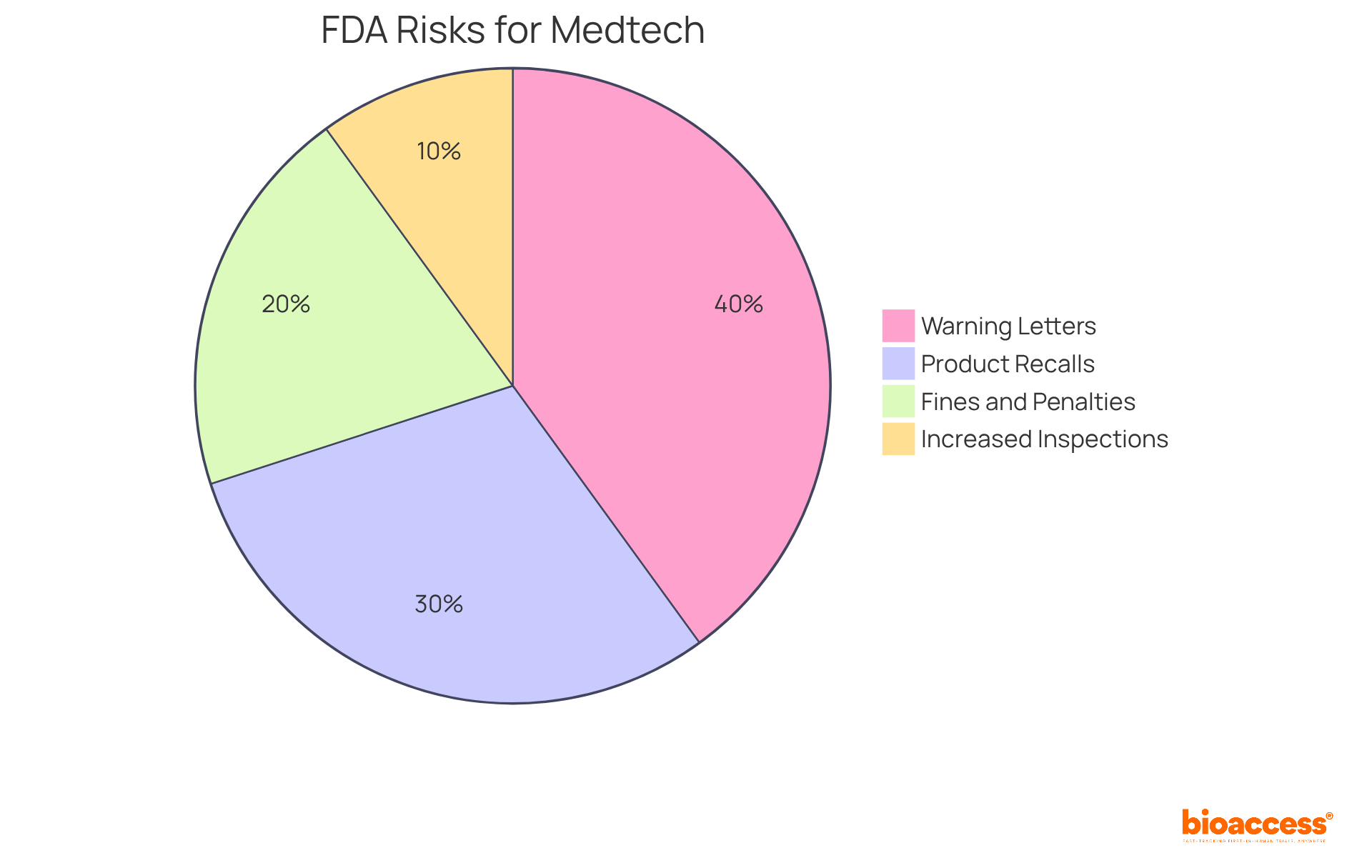
Medtech innovators have several avenues to streamline FDA regulations effectively:
Engaging Early with the FDA: Starting conversations at the beginning can clarify compliance expectations and significantly reduce potential delays in the approval process. Early engagement is crucial, as it allows companies to align their development strategies with FDA requirements, enhancing the likelihood of successful submissions.
Utilizing the FDA's Expedited Programs: Programs such as Breakthrough Devices and Fast Track designation are designed to accelerate the approval timeline for innovative products. These pathways not only enable faster access to the market but also encourage continuous communication with the FDA, which can be essential for navigating complex compliance environments.
Utilizing Real-World Evidence: Integrating real-world data into formal submissions can strengthen assertions of product effectiveness and safety. This approach is increasingly recognized by the FDA as a means to support the clinical relevance of new devices, particularly in demonstrating their impact in diverse patient populations.
Implementing Quality by Design: By integrating quality factors into the product development process, companies can improve compliance and reduce the risk of compliance setbacks. This proactive strategy not only streamlines the approval process but also positions products favorably in the eyes of regulators.
These strategies are crucial for Medtech innovators seeking to navigate the changing compliance landscape effectively, especially as the FDA continues to update its review frameworks and broaden guidance on digital health and AI in 2025.
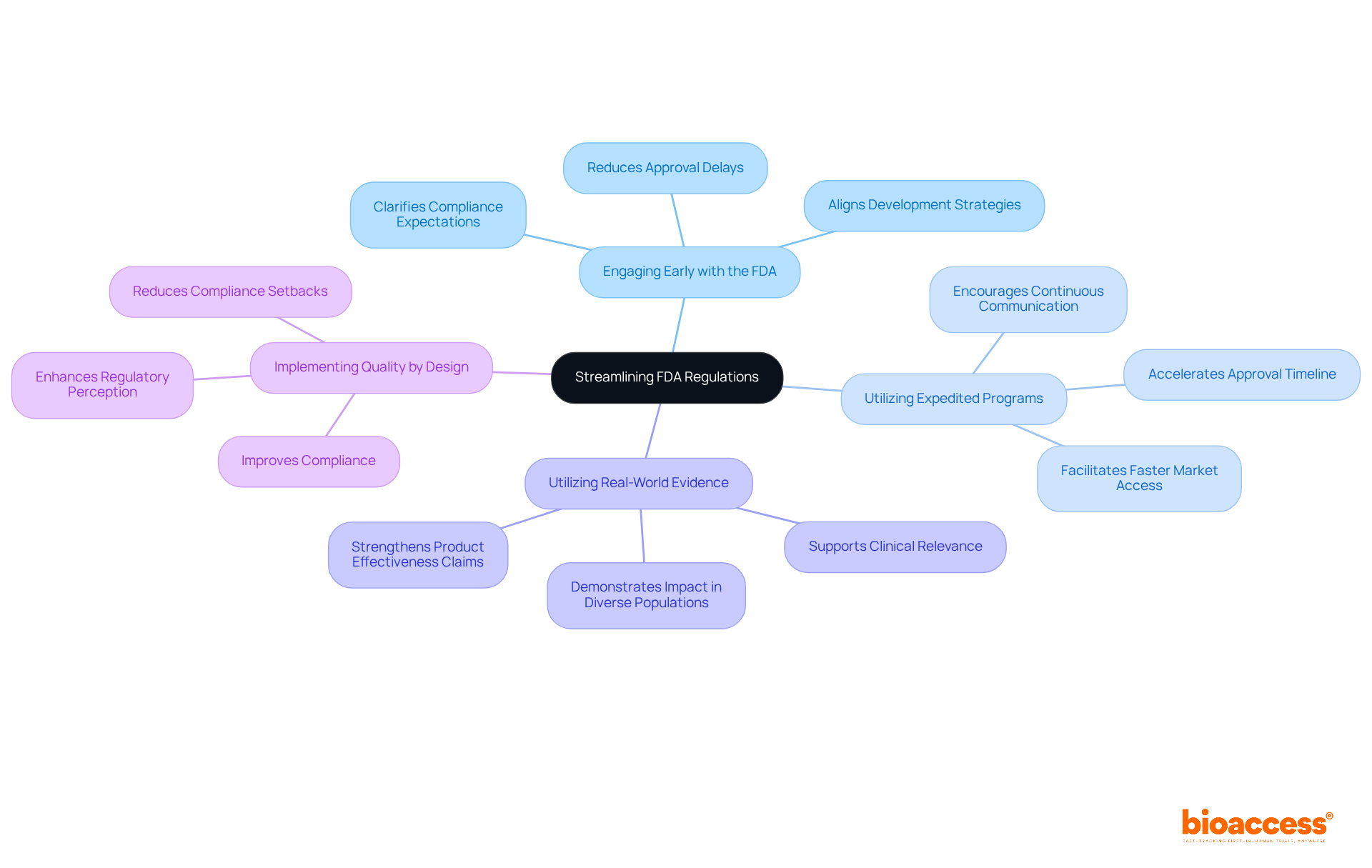
Staying informed about the FDA in UK policy changes is crucial for Medtech innovators. Understanding these shifts not only ensures compliance but also positions companies to leverage new opportunities in the market. Here are key strategies to consider:
By implementing these strategies, Medtech innovators can not only stay compliant but also thrive in a dynamic regulatory landscape.

Navigating the complex landscape of FDA regulations in the UK is a critical concern for Medtech innovators. Understanding and adhering to these regulations is essential for ensuring timely market entry and successful product launches. By leveraging insights from experienced partners like bioaccess®, innovators can streamline their compliance processes, ultimately enhancing patient outcomes and driving advancements in medical technology.
Throughout the article, key discussions emphasize the importance of:
The striking difference in approval rates between companies that engage in pre-submission meetings and those that do not underscores the necessity of thorough planning and clear communication with regulatory bodies. Furthermore, the article outlines critical steps in the FDA premarket approval process, clinical trial guidelines, and the implications of digital health regulations, all vital for maintaining compliance and ensuring product safety.
In a rapidly evolving regulatory environment, staying informed about FDA updates and changes is crucial for Medtech innovators. By adopting strategies such as:
Companies can not only ensure compliance but also seize new opportunities for innovation. The significance of these regulations extends beyond mere compliance; they are foundational to fostering trust and safety in the Medtech industry, ultimately paving the way for advancements that can improve patient care worldwide.
What is bioaccess® and what services does it provide for Medtech innovators?
bioaccess® specializes in guiding Medtech innovators through FDA compliance processes in the UK, leveraging over 15 years of experience to streamline regulatory compliance and enhance product launch success.
How does engaging with the FDA affect the approval rate of Medtech products?
Products that participate in pre-submission meetings with the FDA have a 52% approval rate, compared to a 29% approval rate for those that do not engage in these meetings.
What is the significance of the 510(k) application process?
Approximately 85% of 510(k) applications receive a Substantially Equivalent decision, highlighting the importance of understanding the submission process for compliance and smooth review.
What are the key steps in the FDA premarket approval (PMA) process?
The key steps in the PMA process include: 1. Pre-Submission: Engaging with the FDA early to discuss the product and gather feedback. 2. Submission: Preparing a comprehensive PMA application with extensive clinical data. 3. Review: The FDA conducts a detailed review of the application, which may involve requests for additional information. 4. Approval: Upon satisfactory review, the FDA grants approval for market entry.
What role does informed consent play in FDA clinical trial guidelines?
Informed consent is essential, ensuring participants receive comprehensive information about the trial's purpose, risks, and benefits, allowing them to make educated decisions about their involvement.
How does bioaccess® ensure the success of clinical trials?
bioaccess® employs strategic study designs, robust data monitoring protocols, and ensures timely reporting of adverse events to maintain participant safety and data integrity throughout clinical trials.
What advantages does conducting clinical trials in Latin America offer?
Conducting clinical trials in Latin America provides access to diverse patient groups and streamlined compliance procedures, which can accelerate study timelines and enhance the overall research process.
Why is thorough preparation and communication with the FDA important?
Thorough preparation and clear communication with the FDA are crucial to avoid common pitfalls, ensuring submissions are complete and accurately identify predicate products, which can expedite market entry.